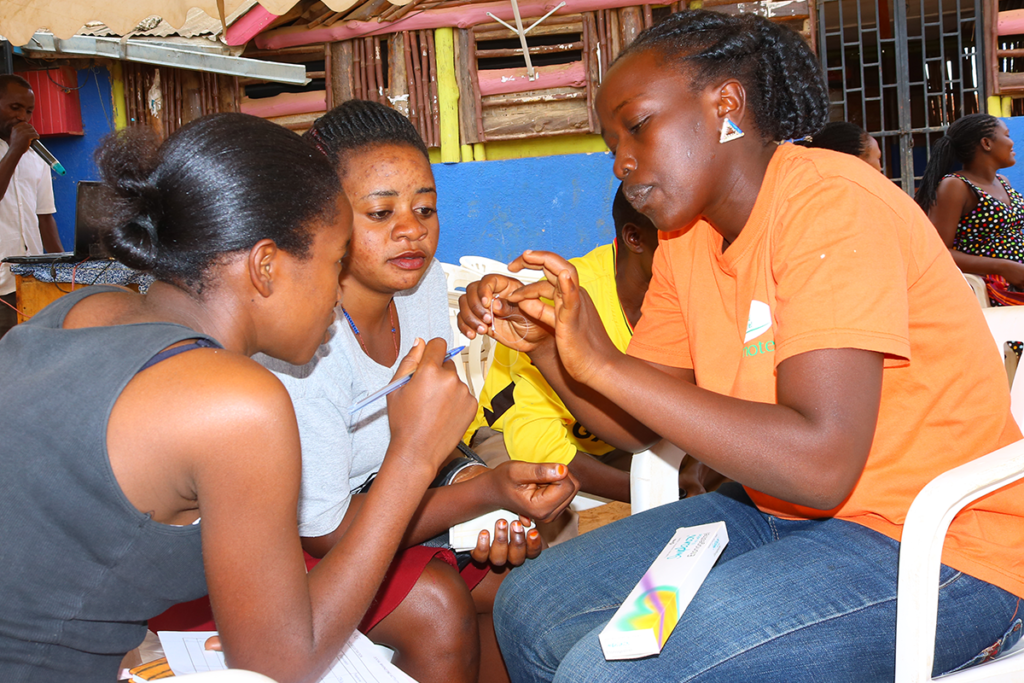Social norms are a hot topic in development. While it seems intuitive that social norms can play a key role in influencing people’s behavior (in both negative and positive ways), the jury is still out on the best way for programs to address norms. We do know that in order to provide evidence on the power of norms change to improve behavior, we need effective ways to measure and monitor norms.
In 2017, as part of the USAID-funded Passages Project, we set out to systematically assess what empirical evidence exists around the relationship between social norms and use of modern family planning methods. You can read the results of our literature review in a new report published in Studies in Family Planning. In this blog post, we detail the methodology of our review and then provide recommendations for bringing greater consistency and comparability to social norm measures.
We started our review by using key word searches in POPLINE to look for original quantitative research focusing on sexual and reproductive health (SRH) and norms. Our search spanned 2005 to 2016 and included terms to ensure that the article touched on all of the following domains: (1) SRH behaviors, (2) norms, and (3) measurement.
At first pass, we identified 2,242 articles, which we compiled in a master EndNote file for title screening by two research assistants. Titles were excluded for any of the following reasons: focus on a non-SRH behavior (i.e., antenatal care); a focus on key populations for HIV prevention only (including intravenous drug users, female sex workers, and men who have sex with men); hormonal or animal studies; training manuals; and commentaries or editorials. All articles retained by at least one reviewer were retained for further screening, leaving 1,778 articles.
 After consultation with the larger Passages metrics and assessment team, we narrowed our focus within these articles to those that examined use of a modern contraceptive method. We used the lexical search feature in EndNote to search each article’s EndNote entry for terms related to modern method use, which we defined as emergency contraception, injectables, intrauterine device, implant, male and female condoms, male and female sterilization, oral contraceptives, and the Standard Days Method.
After consultation with the larger Passages metrics and assessment team, we narrowed our focus within these articles to those that examined use of a modern contraceptive method. We used the lexical search feature in EndNote to search each article’s EndNote entry for terms related to modern method use, which we defined as emergency contraception, injectables, intrauterine device, implant, male and female condoms, male and female sterilization, oral contraceptives, and the Standard Days Method.
This search left us with 911 articles; the abstracts of which were double-screened by two research assistants to confirm the article included a quantitative measure of contraceptive use. Abstracts falling within the exclusion criteria outlined for title screening were excluded at this stage (e.g., studies of key populations, editorials), and articles that described exclusively qualitative assessments, measured only provider attitudes or outcomes, or were in a language other than English were also excluded. This yielded 281 articles that were screened to determine whether the abstract mentioned a quantitative measure of norms or attitudes, bringing us down to 174 potential articles. Mentions of attitudes and beliefs were included at this stage since the language related to norms, attitudes, and beliefs often conflates them and an abstract alone may not give sufficient detail to differentiate.
We retained full text versions of the remaining 174 articles, each of which was assigned to one of three reviewers to look for the following criteria:
- Authors measured use of a modern family planning method as a primary study outcome.
- Authors measured either a behavioral or an attitudinal norm using a specified reference group. The green cells in the table below outline what we mean by a behavioral or attitudinal norm.
- Authors purposefully included social norms as part of a theoretical framework for the study.
- Authors conducted inferential analyses relating the outcome of interest to their norm measurement.
| Behavioral Measures | Attitudinal Measures | |
| Individual (Respondent) | What the respondent does | What the respondent approves of |
| Others(Reference Group) | Norm:What the respondent believes others do | Norm:What the respondent believes othersapprove of |
The three reviewers met periodically to assess the findings for each article and make decisions on inclusion in the literature review. After reviewing the 174 articles, we found only 17 studies met all four criteria. Across these studies, no single measure of social norms was used in more than one study and there also was a lot of inconsistency in the terminology used to describe how the measures were created. Of the 17 studies reviewed in full, almost all of the studies focused on condom use as a behavioral outcome and most were conducted in sub-Saharan Africa.
While we were hoping to find best practices for designing surveys that measure both social norms and contraceptive use, our review revealed a general lack of standardization and a need for more studies that systematically measure social norms. More work is still needed to fully understand the relationship between social norms and contraceptive use, but our research points to some recommendations that could bring greater consistency and comparability to social norm measures. After all, if you don’t measure it, how do you know if it changed?!
Here are our top recommendations from the report:
- Additional research is needed to bolster the evidence base around social norms and contraceptive use, particularly looking at methods other than condoms. There is also a need for data collection on social norms that uses robust study designs, including studies that randomize selection and are conducted longitudinally.
- Researchers should allow respondents to identify the type of people or the specific people in their lives who influence their behavior (e.g., rather than assuming friends are the most relevant influencers or reference group). Studies and programs can also distinguish between reference groups for who’s doing the behavior and those who approve of the behavior.
- Authors should clearly specify the type of norms they are seeking to measure and the theoretical framework they are using to conceptualize their measure to help reduce conflation around terms like social norms, gender norms, normative beliefs, etc. In turn, journal editors and reviewers should require this type of clarity in submitted manuscripts and should advocate increased use of standardized or commonly used terms and measurement approaches.
- We encourage researchers and practitioners to consider measuring social norms at a more collective level. In other words, as opposed to relying solely on individual, self-reported data – like we collect in most surveys and program evaluations – instead think about looking for data that indicates change at more macro program or policy-levels. With these data, there may be fewer concerns with biases and reference groups and thus they may be more a more accurate representation of norms.
An abbreviated version of this post originally appeared on the blog of Georgetown University’s Institute for Reproductive Health.
Photo caption: A health worker demonstrates how to use an IUD to two women at their workplace in Kampala, Uganda.
Photo credit: © 2016 UHMG Uganda/Geofrey Kasumba, Courtesy of Photoshare



